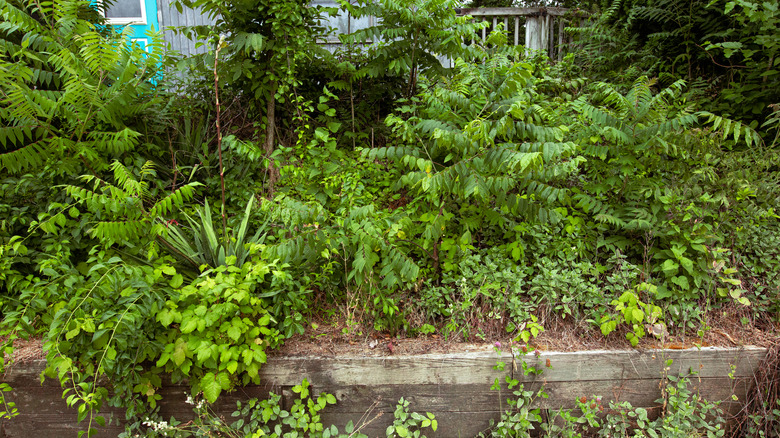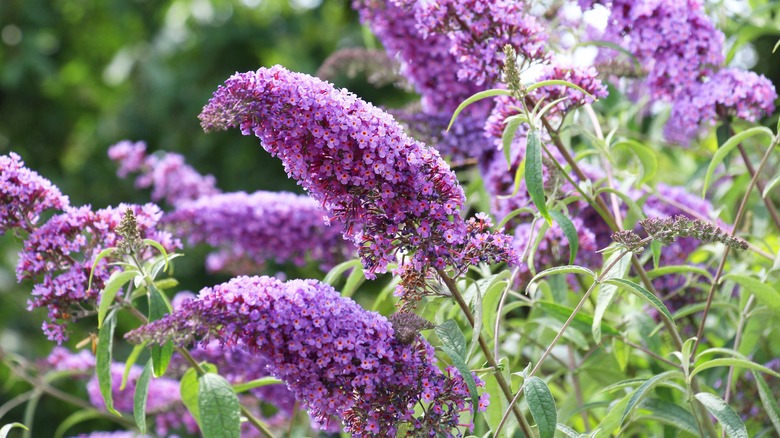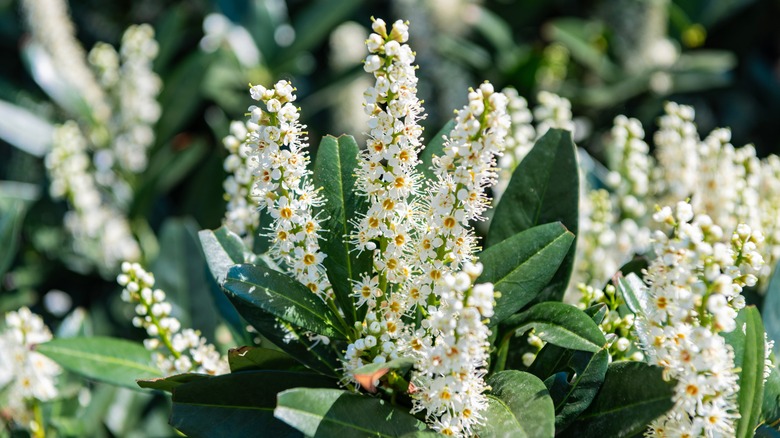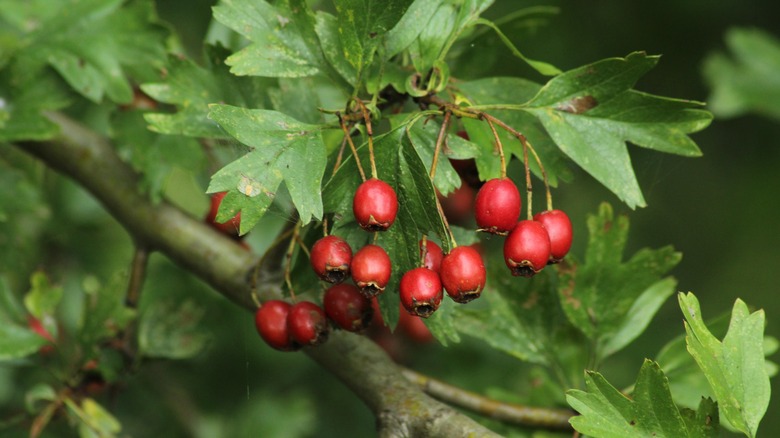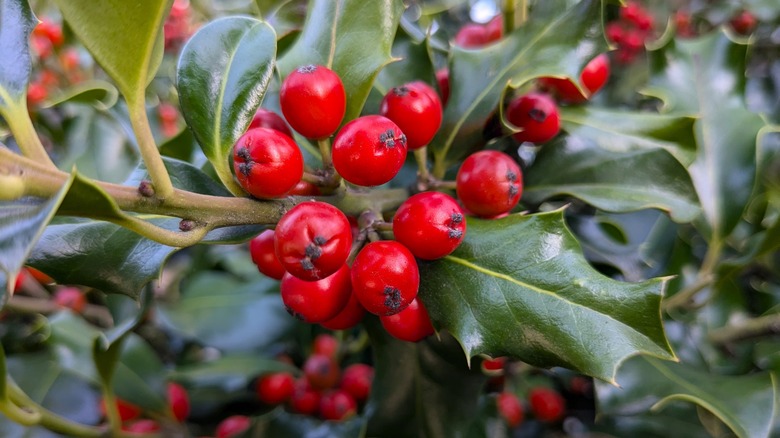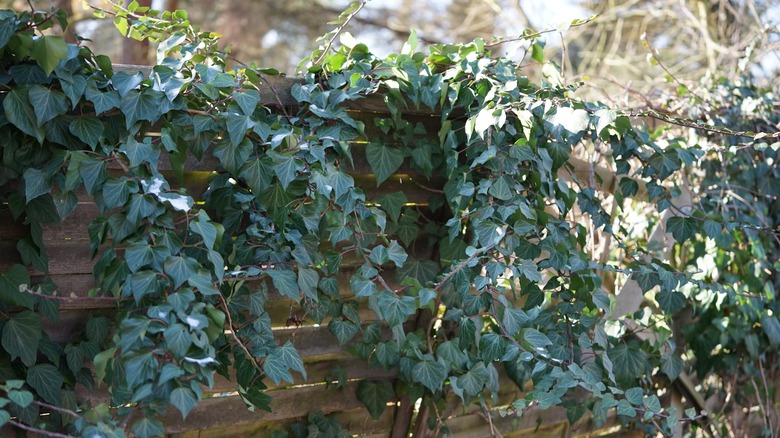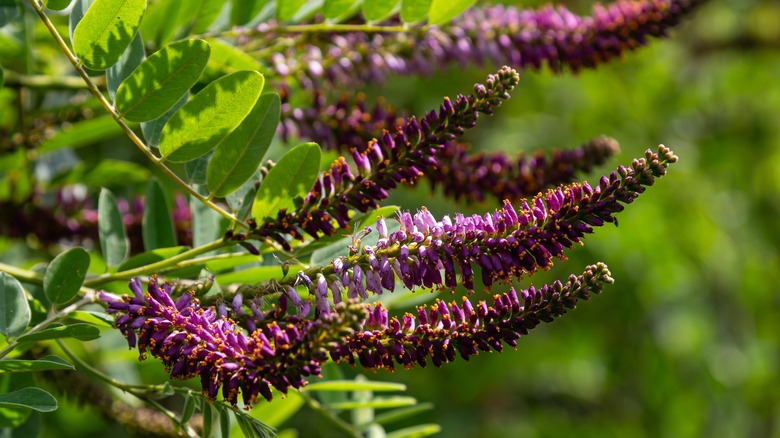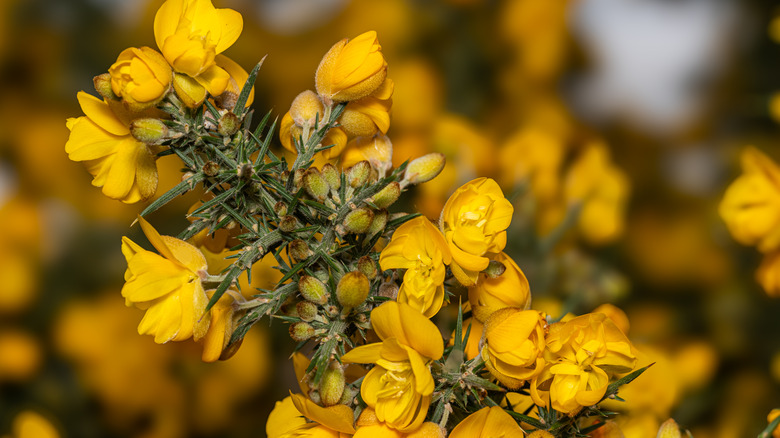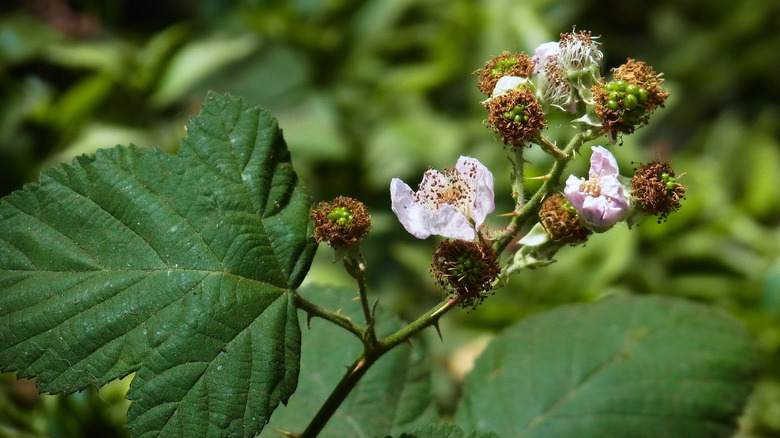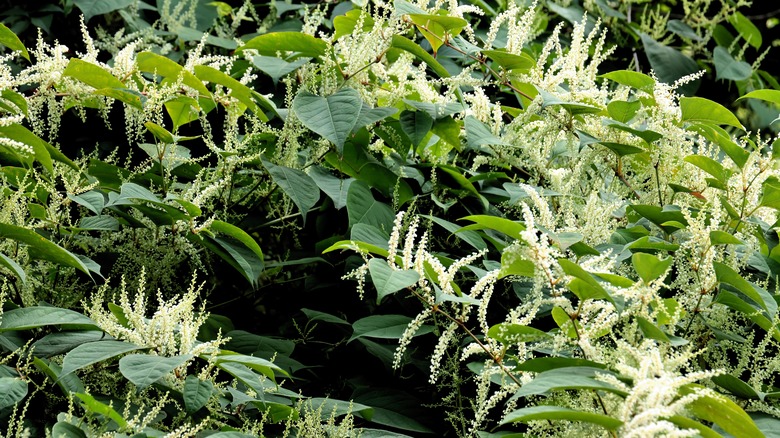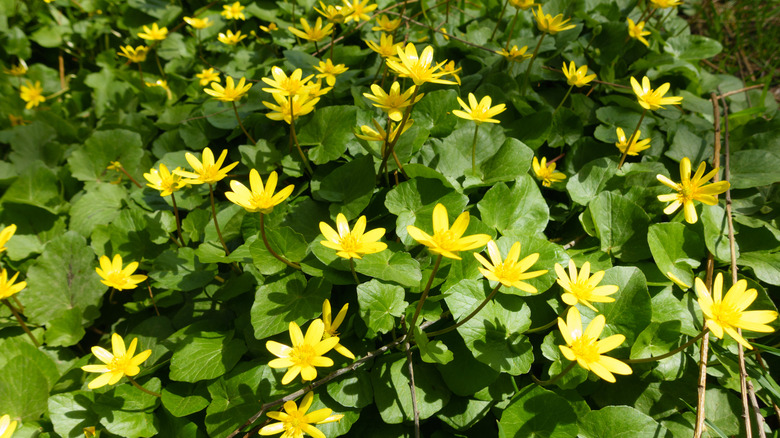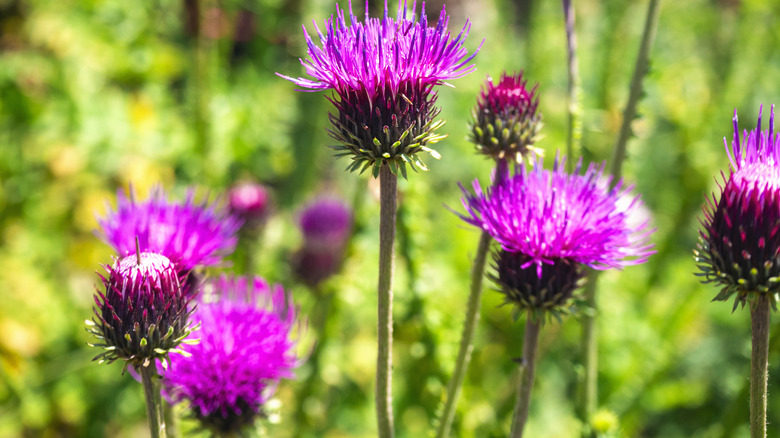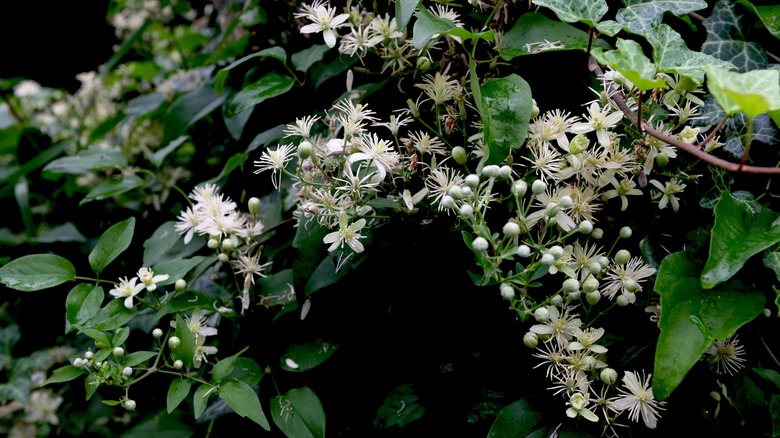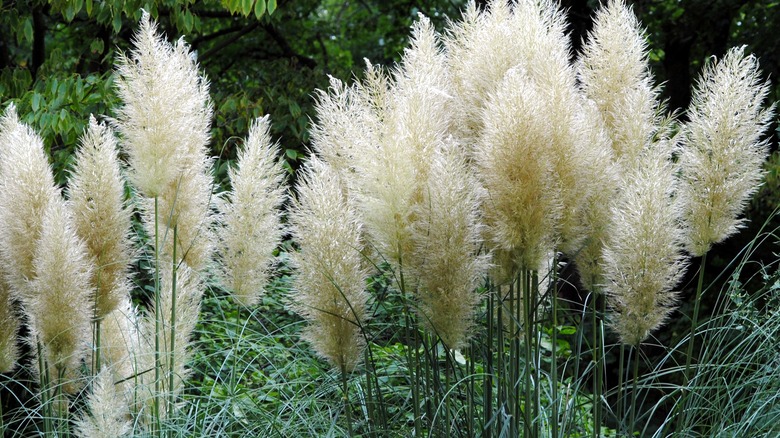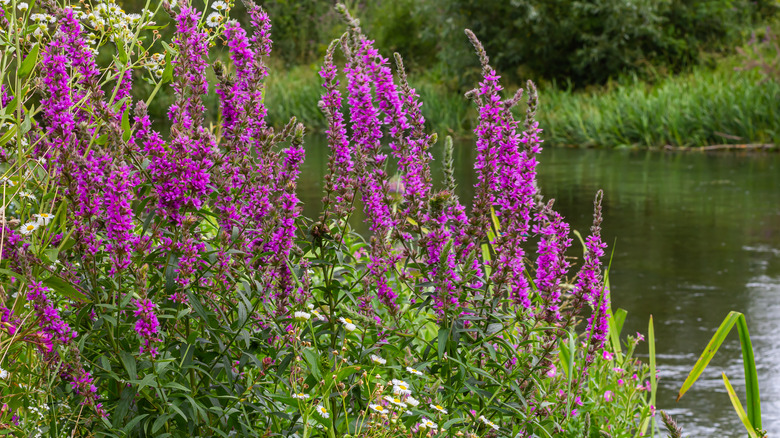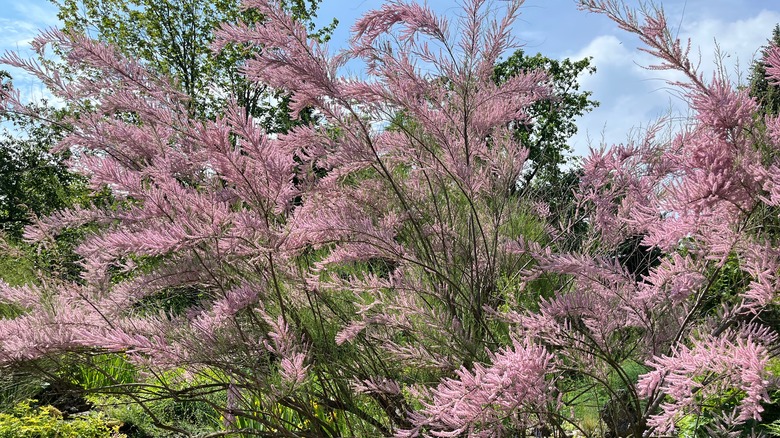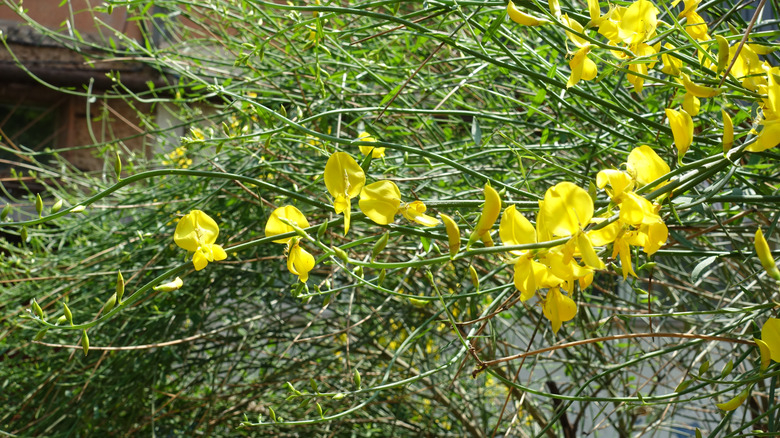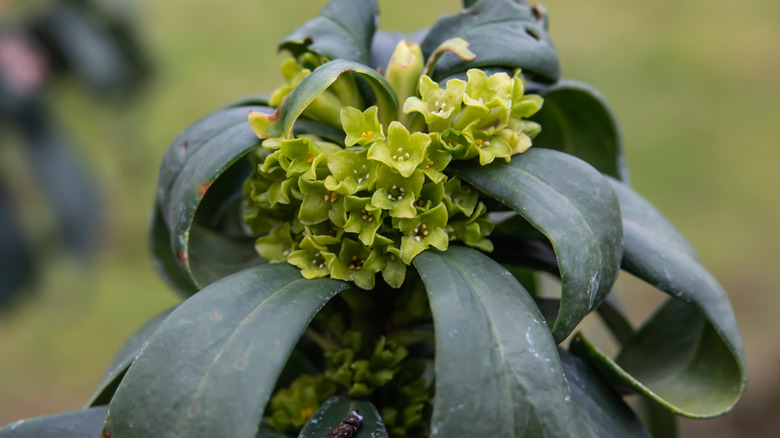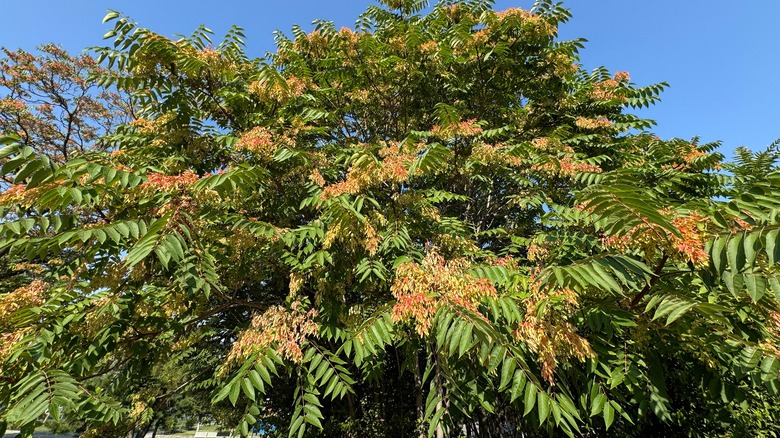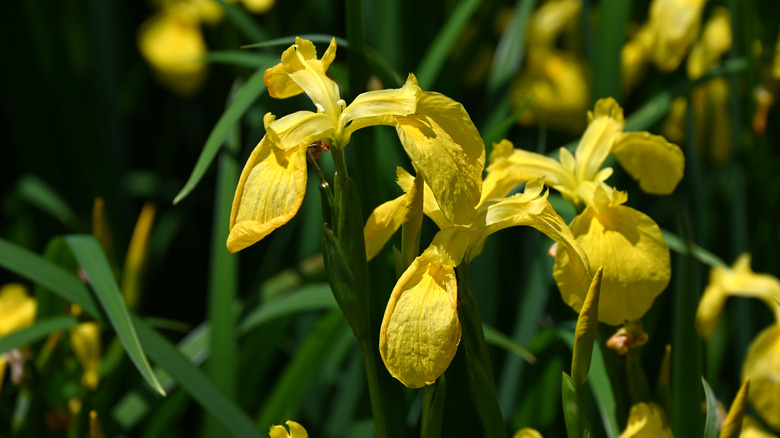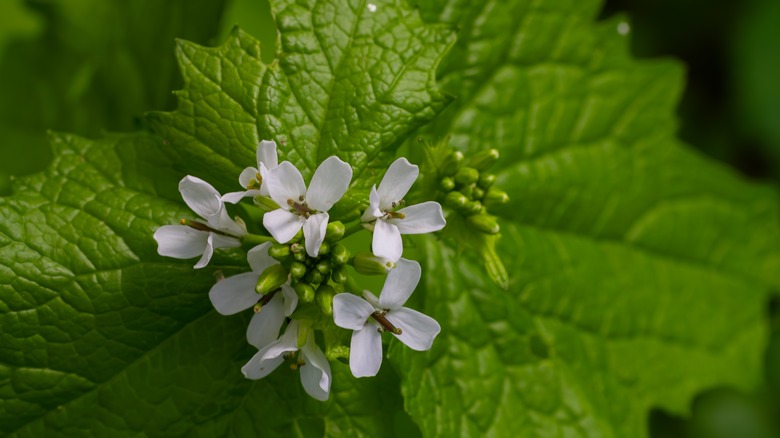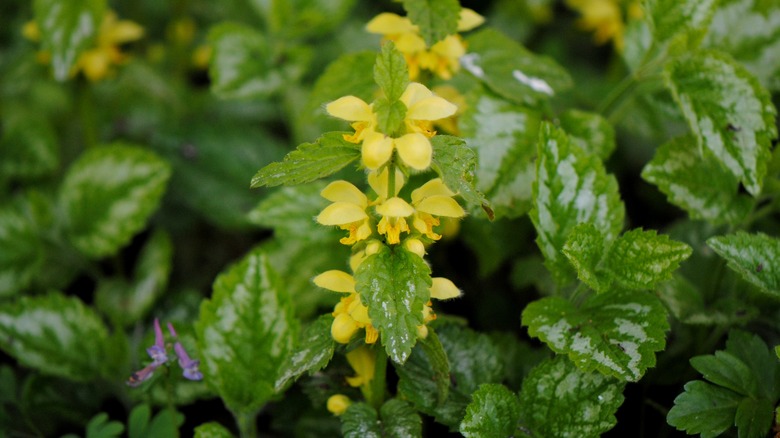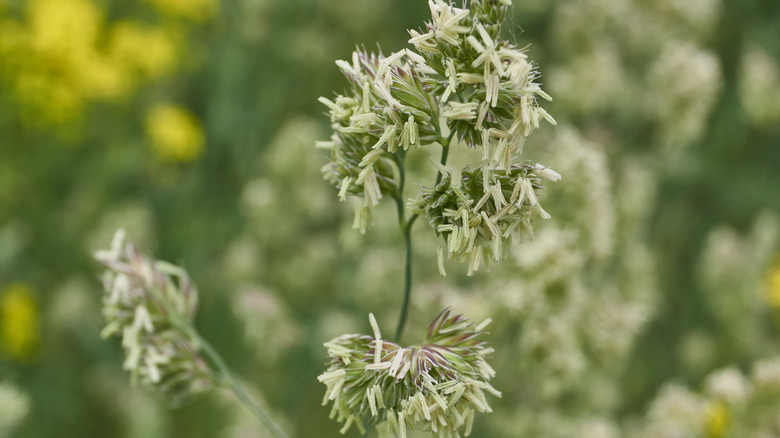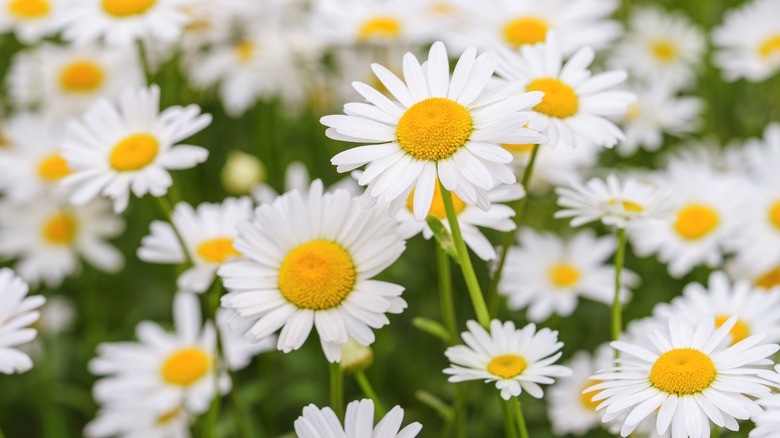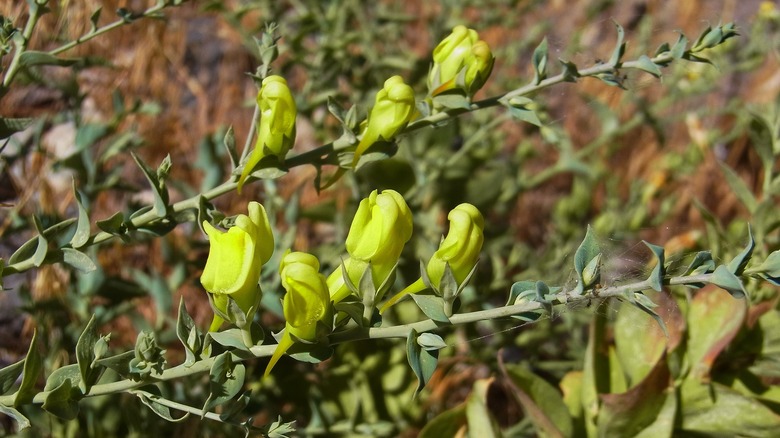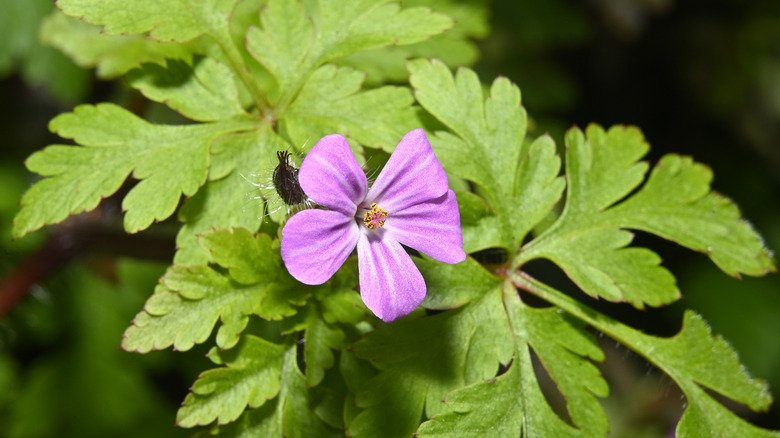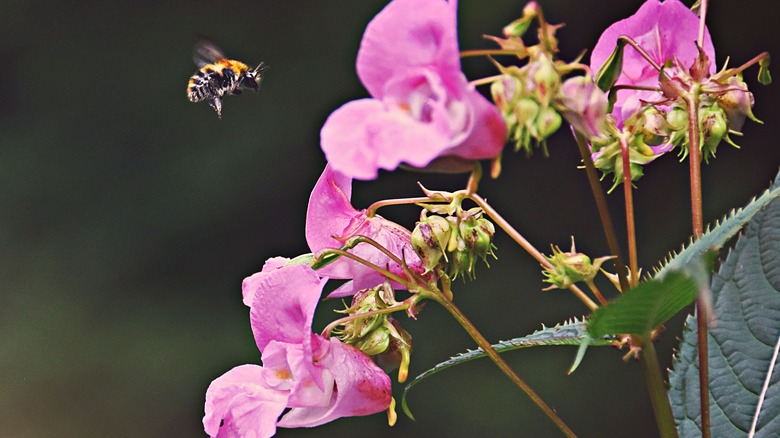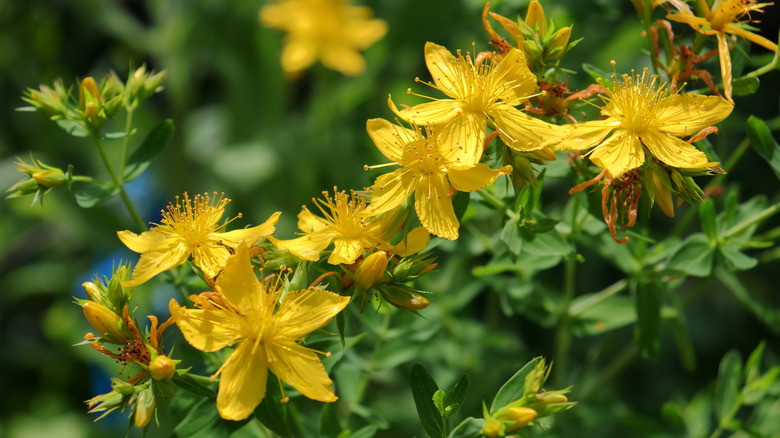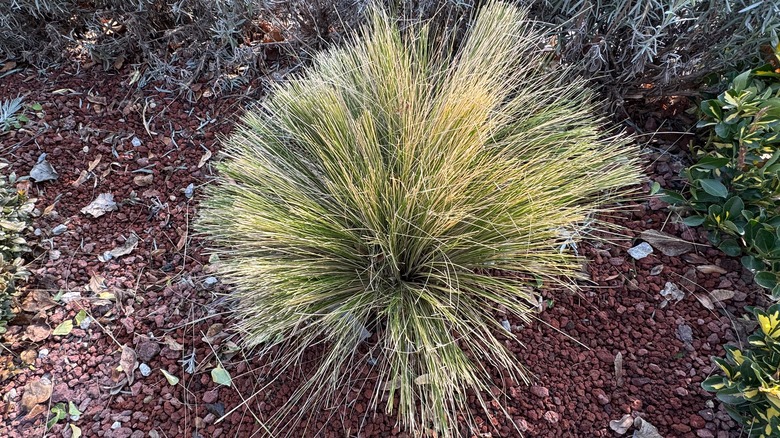Invasive Plants Along The West Coast You'll Want To Think Twice Before Growing
The next time you venture out to the nursery for ornamentals to plant in your garden, pay attention to more than just their cultural requirements. It's essential to double-check they aren't considered invasive to your area. Over the years, many non-native plants have become problematic, necessitating states to spend a significant part of their budget on controlling their spread. Examples along the West Coast, which comprises California, Oregon, and Washington, include butterfly bush, cherry laurel, hawthorn, ivy, purple loosestrife, tree-of-heaven, and many more, as you'll discover shortly.
Left unchecked, invasive plants clog native ecosystems, altering the natural composition of plants or inhibiting forest regeneration. This adversely affects the dependent local wildlife, thwarting their movement or depriving them of food and cover. Sometimes, these invasives also become weeds in croplands. Since several of these specimens have drifted from home gardens, homeowners need to make active efforts not to plant them anymore. Wherever possible, existing plantations should also be duly weeded out. Do note that these rules apply only to the areas where these plants are declared invasive and can be, otherwise, safely planted anywhere else in the U.S. With that established, make sure to avoid planting the following 28 invasive plants if you live on the West Coast.
Butterfly bush
Not only is the butterfly bush (Buddleja davidii) one of the most invasive shrubs on the East Coast, it's just as bad a nuisance on the West Coast, including the three key states of California, Washington, and Oregon. While adult butterflies certainly adore this plant, they don't utilize its foliage for egg-laying. So, when butterfly bushes invade natural areas, they risk overrunning native plants that caterpillars actually feed on, adversely impacting their population. That being said, you may still grow sterile cultivars in these states, as their seed production is minimal. Oregon-approved Buddleja cultivars include 'Purple Haze' and 'Asian Moon'.
Cherry laurel
Cherry laurel (Prunus laurocerasus) is a smooth shoo-in for most urban gardens. It heralds spring with perfumed, white blooms, quickly establishes a living screen, is liked by birds, and on top of it all, it's highly adaptive. Not even deep shade or infertile soils can thwart its growth. Unfortunately, this adaptability and vigorous growth have made it invasive in Oregon, with its seeds and roots escaping bounds and establishing in adjoining areas. By forming impenetrable thickets, cherry laurel blocks light for understory plants, impairing native ecosystems. Washington has them on the monitor list and discourages their planting.
Common hawthorn
Rethink landscaping your yard with groups of common hawthorn (Crataegus monogyna). Granted, this shrub is highly decorative, makes a dense hedge, and offers crucial bird food during fall and winter, but it's a problematic species. American robins, in particular, spread their seeds to natural habitats that are quickly overrun with this European import. Apart from impairing plant succession by hybridizing with native hawthorns, these thickets prevent animal traffic. California and Oregon consider common hawthorns an invasive species and discourage new plantings. In Washington, they're a Class-C noxious weed, with counties expected to regulate their spread as deemed necessary.
English holly
No Christmas decor is complete without the pretty leaves and crimson red berries of English holly (Ilex aquifolium). Birds, too, rejoice at the sight of their fruits as they persist through the cold months. Yet, for all the winter interest, English hollies are a poor planting choice if you live in California or Oregon, where they've become invasive. Through seeds that remain viable for nearly 12 years, they've invaded forested regions along the West Coast. Because Washington considers holly as its legacy crop, it has tasked the counties to regulate this Class-C noxious weed in home gardens abutting natural areas.
English ivy
Think twice and then some more before setting English ivy (Hedera helix) free on the ground or training it and its cultivars over walls and trellises. Thanks to its vigorous growth, English ivy has escaped and sprouted in the wild, shading out and outclassing native vegetation. Its added weight over the canopies makes the native trees unable to withstand storm damage. English ivy can also harbor harmful bacteria that inflict leaf scorch in oak and elm trees. It's invasive in California and Oregon, and is on the quarantine and Class-C noxious weed list of Washington, so consult your county's control recommendations.
False indigo
False indigo (Amorpha fruticosa), or indigobush, injects a pop of lavender in summer gardens with its fragrant blooms and is valuable to many butterflies and moths seeking local plants for their larvae. However, if you live in Oregon or Washington, you might want to ditch this plant altogether. The reason is that its seeds have dispersed far out and naturalized around the stream and river banks on the west coast, blocking recreational access while smothering native plants. Washington also has it on its quarantine list, thus banning any sale and purchase of false indigo.
Gorse
Gardeners around the coast may be tempted to tap yellow-flowering gorse (Ulex europaeus) for erosion control. However, this would be a mistake. Also listed on the Global Invasive Species Database, gorse is a tough-as-nails plant that can survive in most conditions, in part due to its nitrogen-fixing abilities. It also makes the habitat inhospitable to natives by altering the soil composition and packing the land with many seeds. Collectively, gorse thickets can worsen fire, making them dangerous in wildfire-prone areas. For these reasons, they're considered noxious weeds and invasive in California and Oregon, with Washington prohibiting their sale and distribution altogether.
Himalayan blackberry
Bees and birds like the flowers and berries of Himalayan blackberry (Rubus bifrons, previously R. armeniacus). Yet, you must think twice before planting this gorgeous perennial shrub in your garden. In sunny areas, it can produce over 7,000 seeds every year, enabling its aggressive colonization. Its roots have escaped cultivation into natural areas where they form tall thickets and shade out the understory vegetation. Also known as Armenian blackberry, this plant is considered invasive across the Pacific Northwest, including California, and a noxious weed in Washington and Oregon, and shouldn't be grown in these areas.
Japanese knotweed
Japanese knotweed (Polygonum cuspidatum or Reynoutria japonica) is a notorious weed that could tank your home's value before you sell. The reason? It's difficult to eliminate — you're looking at a 5-year time frame with diligent work — once it establishes in home gardens. Introduced as an ornamental shrub that could arrest soil erosion, it has since overtaken native vegetation in nearly 36 U.S. states, including those on the West Coast. Besides being a prolific seeder, it sends out underground stems that can spread 65 feet across and 7 feet deep! Their thick stands can also fuel fires.
Lesser celandine
Lesser celandine (Ficaria verna), or fig buttercup, is widely planted to bring in early spring color. However, since its introduction, it has become an invasive species in the Pacific Northwest, the Midwest, and the eastern U.S. Although not yet problematic in California, Oregon and Washington consider it a noxious weed and disapprove of new plantings. In gardens and lawns, lesser celandine establishes extensive patches through tubers and seeds that spread elsewhere on equipment, boots, or the wind. Since it's ephemeral and so short-lived, management takes many seasons, giving it ample time to dominate and degrade riverbanks, wetlands, and woodlands.
Milk thistle
Grown for its medicinal and ornamental qualities, milk thistle (Silybum marianum) is a biennial herb with the propensity to escape into the wild, pastures, and disturbed habitats. It achieves this escape by seeding profusely, with the wind helping in moving the seeds to far-off places. Since its foliage contains compounds toxic to livestock and often dominates native plants, milk thistle is considered invasive in California and Oregon. Washington has prohibited its planting and distribution and has classified it as a Class A noxious weed, where current plantings must also be controlled.
Old man's beard
California lists old man's beard, or evergreen clematis (Clematis vitalba), as an invasive species, while Oregon and Washington treat it as a noxious weed, though in the latter's case, counties stipulate how you treat this species. Like ivy, evergreen clematis is a vigorous vine that can suppress other plants by blocking their access to resources or causing the complete collapse of the forested trees it clings to. Apart from rooting at their stems, these unruly plants secure their monopolization through copious seeding. Direct contact may cause skin irritation.
Pampas grass
There are many reasons why planting pampas grass can be a huge mistake — being invasive is a primary concern. Scientifically called Cortaderia selloana, pampas grass is a highly ornamental plant that roots thickly enough to prevent leaching. Unfortunately, it also produces an inexhaustible cache of seeds that winds freely transport to distant areas. Due to this, pampas grasses have overtaken sandy riverbanks, with their dense foliage shading out native shrubbery. They're held as an invasive species in California, while Washington treats them as a noxious weed that the local counties must regulate depending on the grasses' spread.
Purple loosestrife
Mass-planted, purple loosestrife (Lythrum salicaria) plants present a spectacular image in the summer when their purplish-pink flowers are in bloom. However, across most of the U.S., including California and Oregon, purple loosestrife is considered a weedy invasive. Thanks to the million seeds it produces annually, it has taken over wetlands. Its domination over native plants has deprived waterfowl of critical habitat. In several U.S. states, including Washington, it's illegal to trade and plant purple loosestrife and its cultivars, as some of them can readily cross-pollinate and naturalize.
Saltcedar
Saltcedar, or pink tamarisk (Tamarix ramosissima), may look immensely pretty with its pastel pink blooms, but it's highly damaging to the coastal ecosystem. Saltcedars have a high capacity to drink water because of their long taproots and, left unchecked, can dry water sources, including groundwater. Worse yet, they produce seed-containing salt capsules that prevent native plants from establishing, thus securing their free rein. Given moist soils, they can re-establish themselves from root fragments, creating monocultures that don't serve the local herbivores. They're an invasive plant in Oregon and California, and a Class B noxious weed in Washington.
Spanish broom
Bearing a close resemblance to gorse, Spanish broom (Spartium junceum) is another yellow-flowering shrub you must reconsider planting. A nitrogen-fixer, Spanish broom alters the soil profile and populates the dirt with thousands of seeds that remain viable for over five years. Given these capabilities, it has outdone native vegetation in the fight for resources and taken over their land. Because the summer heat dries their foliage, these shrubs can aggravate fires. They're deemed invasive in California and Oregon, with Washington listing them as a Class A noxious weed that shouldn't be planted, sold, or bought.
Spurge laurel
You might like spurge laurels (Daphne laureola) for their rhododendron-like appearance that offers plenty of winter interest and pollinator action. While their blue fruits are a hit with the birds, these feathered creatures defecate the seeds elsewhere, promoting their spread. As a result, spurge laurel has displaced understory plants in oak and evergreen woodlands, along with the animals dependent on them for food. Moreover, spurge laurels exude a sap toxic to humans and pets and shouldn't be handled without protection. It's on Washington State's quarantine list, which bars its trade and planting, and is considered a noxious weed in Oregon and accordingly controlled.
Tree-of-heaven
In the 1850s, tree-of-heaven (Ailanthus altissima) was introduced to the West Coast as a fast-growing, ornamental shade tree that could thrive in the poorest of soils. Ever since, it has become a noxious weed and invasive across the country, including California, Washington, and Oregon. Tree-of-heaven produces thousands of seeds. Dispersed over the wind to natural habitats, these seeds root and develop numerous suckers, establishing dense thickets that outcompete native vegetation. Apart from releasing allelochemicals, they host spotted lanternflies, an invasive pest that feeds on fruit trees. For these reasons, think twice about planting a tree of heaven anywhere near your home.
Yellow flag iris
Used to populate muddy and boggy yards, yellow flag iris (Iris pseudacorus) is another herbaceous perennial you must swear off if you live along the West Coast (or even the Midwest). In home gardens, they spread via rhizomes and overrun the area, turning weedy. They also produce many seeds, which have rooted to form dense thickets along the wetlands and have displaced the native vegetation, and by extension, nesting and breeding sites for birds. Grazing animals grow sick after feeding on their foliage. For these reasons, yellow flag iris is considered an invasive species and shouldn't be planted in any of the West Coast states.
Garlic mustard
Typically grown as a culinary herb, garlic mustard (Alliaria petiolata) is another species you must avoid growing if you live along the coast. Once established in the garden, garlic mustard isn't easily removed because it produces lots of seeds that remain viable for years and is allelopathic. Over time, these seeds disperse to roadsides, parks, and even woodlands, where the newly rooted garlic mustard stands have wreaked havoc on the local ecosystem. The West Virginia white butterfly, a rare species, is experiencing a decline in population because it's tempted to oviposit on garlic mustard's foliage, but its larvae cannot feed on it.
Yellow archangel
Yellow archangel (Lamium galeobdolon) is a prized ornamental around the Pacific Northwest, as it reliably adapts to dry shade and quickly fills out bare patches. Unfortunately, it doesn't stop at its ordained boundaries and freewheels into forested areas via runners and seeds, where its shade tolerance enables it to take over the area. Worse still, it displaces the local wildlife, which, despite the dense foliage, avoids taking cover in it. Since it can regrow from stem fragments, yellow archangel can be tricky to eliminate from landscapes. It's a noxious weed in Oregon and Washington and shouldn't be planted in these states.
Reed canary grass
Introduced as a forage crop, reed canary grass (Phalaris arundinacea) has since become invasive in over 15 U.S. states, including Oregon and Washington. Owing to their variable origins, control is necessary for both native and non-native reed canary grasses, and especially their vigorous cultivars. After escaping from residential lots, these grasses are known to establish monocultural stands around wetlands. They do this by effectively cloning themselves through rhizomes and self-seeding. Despite being tall, they don't offer much shade, making the sites inhospitable to aquatic wildlife, including salmon. So, to safeguard the coastal ecosystem, avoid planting it.
Oxeye daisy
Sprawled in the yard, oxeye daisy (Leucanthemum vulgare) plants beam waves of yellow-bead white petals and invigorate our senses with their sage-like smell. So, it's unfortunate that they've become invasive across the Pacific West, including California and Oregon. Washington classifies them as a noxious weed whose management is the prerogative of the local counties. Besides seeds, oxeye daisies spread through rhizomes and are particularly problematic in fields and pastures where they compete with crops for resources. Otherwise, too, they're known to dominate the native ecosystem by choking out the existing plantation, including wildflowers, and so shouldn't be planted.
Dalmatian toadflax
Despite its short life, Dalmatian toadflax (Linaria dalmatica) has become a significant problem in the western U.S. ever since its introduction in the 1800s. By producing nearly 500,000 seeds in its lifetime that remain viable for a decade, it has conquered the native lands and pastures, harming the ecosystem as well as the livestock that forage on its toxic foliage. Since it roots deeply — up to 10 feet in some cases and can spread similarly far — it isn't easily removed from gardens after establishment. It features on Washington state's quarantine list, where it's also considered a Class B noxious weed and is invasive in California and Oregon.
Robert geranium
Robert geranium, or herb-robert (Geranium robertianum), is a noxious weed in Oregon and Washington, with the latter also placing it on its official quarantine list, thus banning any trade or new plantings. Pretty pink petals make way for peaked capsules, with the brown seeds lofted nearly 20 feet away from the mother plant, creating a boundary breach. Additionally, Robert geraniums are highly adaptable — even tolerating full shade — and have overtaken the wooded and mountainous lands, depriving native plants of their berths. While they can certainly be easily yanked out for management, their leaves release an offensive odor when crushed.
Policeman's helmet
Policeman's helmet (Impatiens glandulifera) is a problematic species in California, Washington, and Oregon, along with the Mid-Atlantic states. Also known as Himalayan balsam or ornamental jewelweed, this herbaceous annual has spread to riparian areas and forested lands. It does this by throwing away the seeds nearly 20 feet away, which, on becoming wet, readily germinate and establish themselves, suppressing native plants. However, being annuals, they die back in winter, leaving the ground bare and amenable to erosion. This subsequently lowers water and habitat quality for fish and their water-loving companions.
Common St. John's wort
Invasive in California and Oregon and a Class C noxious weed in Washington, common St. John's wort (Hypericum perforatum) is an ill-advised planting in these states and the Midwest. Overexposure to this weed adversely affects animals, making their skin sensitive to sunlight and prone to blistering and burns. It's also difficult to manage in landscapes because it has various means to ensure its spread. Apart from producing multiple seeds that remain viable for over 30 years and are easily wind-dispersed, it shoots out underground runners and creeping stems that root on soil contact.
Mexican feathergrass
Mexican feathergrass (Nassella tenuissima) has recently been moved from the "Watch" list to the "Do Not Plant" list in California. That's because this ornamental grass has escaped from residential yards to the surrounding disturbed or natural sites along the coast as well as inland, along the valley and the mountains. It produces many seeds that are dispersed through foot traffic, equipment, animal movement, or air. Planting feathergrass in your garden will not only increase the time spent on weeding your yard but will also harm the native ecosystem. Since it thrives in dry areas, its presence can worsen wildfires.
